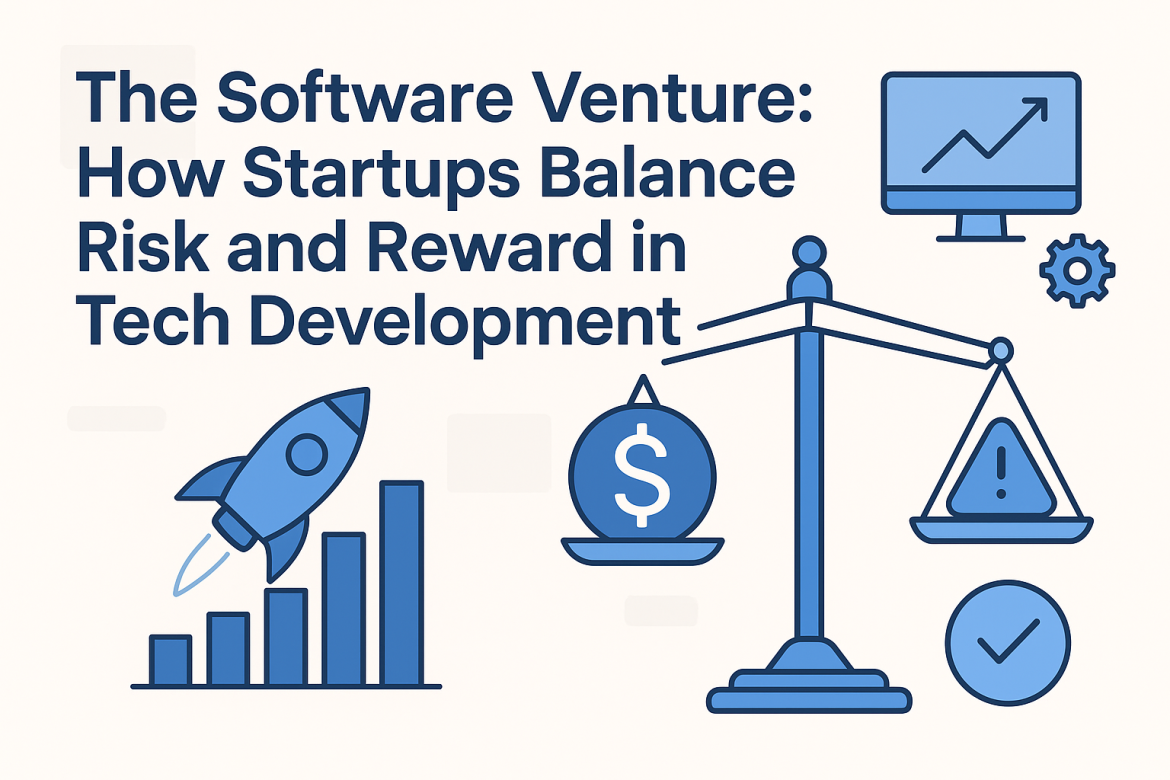Table of Contents
In the ever-evolving landscape of technology, startups walk a razor‑thin edge between explosive opportunity and existential peril. Launching a software venture is an exercise in strategy: managing scarce resources, navigating shifting markets, and making decisions that could either catapult a startup to success or send it crashing. This article explores how founder teams in software startups navigate the twin imperatives of risk and reward—through smart planning, agile iteration, and disciplined adaptation—and why even high‑risk, high‑reward experiments occasionally enter the narrative as bold, illustrative gambits.
1. The Risk–Reward Paradox in Software Startups
Startups thrive on innovation—but innovation is inherently risky. Uncertain markets, fluid customer needs, evolving technologies, limited capital, and lean staffing combine to create a milieu where every decision counts.
The upside is compelling: create the right product at the right time, and even a small team can disrupt entire industries.
2. Using Lean Principles to De-Risk Development
A cornerstone strategy in startup software development is the Lean methodology, introduced by Eric Ries. Central to this framework is the concept of the minimum viable product (MVP)—a simplified version designed to test core assumptions with minimal effort and cost. This allows teams to learn quickly whether the idea resonates.
Complementing the MVP mindset, teams embrace continuous deployment. Some roll out new updates many times per day, reducing cycle time and increasing responsiveness.
All of these efforts feed into the Build–Measure–Learn feedback loop—the engine driving validated learning and informed pivots.
3. Embracing Agile and Iterative Development
Agile methodologies, such as Scrum and Kanban, empower early‑stage teams to segment work into manageable chunks and reassess priorities continuously. This iterative cadence accelerates learning and curbs the cost of errors.
Organizations adopting Agile practices benefit from greater flexibility, earlier feedback cycles, better visibility, and faster time‑to‑market, all of which mitigate project risk.
Continuous integration and delivery (CI/CD), automated testing, and regular code reviews further reduce defect rates and deployment risks.
4. Structured Risk Management Techniques
Even with Agile mindsets, structured risk management remains critical. Founders must systematically identify, assess, and prioritize potential risks. Tools such as risk registers and risk matrices help teams catalog possible threats—from technical challenges to market shifts—with clarity and organization.
Conducting risk workshops, brainstorming sessions, and analyzing historical failures (or near-failures) aid in surfacing hidden threats.
Each risk is then analyzed for likelihood and impact, helping to rank them and decide where mitigation efforts should focus.
Once prioritized, risks are addressed proactively via:
● Avoidance: Eliminating unnecessary or overly complex features.
● Mitigation: Increasing testing, limiting scope, or building fallback mechanisms.
● Transfer: Outsourcing risky components to specialized partners.
● Acceptance: Proceeding knowingly when risks are low or mitigation is too costly.
Throughout, teams monitor risks continuously, revisiting their assessments regularly and updating strategies as new information emerges.
5. Cultivating a Risk‑Aware Culture
Tools and processes only work when embedded within a culture that values transparency and adaptation. Encouraging open communication, holding regular retrospectives, and sharing insights builds organizational resilience.
This fosters an environment where risks are not swept under the rug but surfaced, scrutinized, and addressed collaboratively.
6. Balancing Depth with Agility in Complex Tech
For deep‑tech startups involving novel hardware, AI, or other complex systems, traditional Lean methods can fall short. These ventures often require extended research, prototypes, and iterative validation across multiple dimensions.
Such “hard tech” startups demand balancing technical development timelines with market expectations—and often involve greater upfront capital and longer runway.
7. Pivoting Based on Validated Learning
Failure isn’t fatal—unless ignored. In many startups, the critical outcome isn’t whether a feature fails, but whether the team learns from it. Pivots—changes in business model, customer segment, or technology—are often triggered by validated feedback.
This attitude transforms risk into insight, reinforcing the feedback loop and enabling strategic redirection.
8. Outsourcing vs In‑House: Managing Tradeoffs
Startups sometimes outsource parts of their development—like UI design, backend infrastructure, or QA—to access skills and reduce risk.
However, outsourcing introduces dependencies. Effective collaboration, clear contracts, and good interpersonal relationships are essential to make it viable.
9. External Validation and Stakeholder Confidence
Robust risk controls—structured assessments, regular updates, responsive development cycles—build confidence among investors, partners, and early customers.
By demonstrating discipline and adaptability, startups signal that they can handle adversity while still moving fast.
A Dramatic Illustration:
As a bold example of calculated risk, a live initiative can serve as a metaphor. Imagine a startup creating a live‑streamed game platform where users play with crypto in real time. It’s high‑stakes, edge‑of‑risk—and yet it embodies many core startup tactics: launching MVPs, experimenting in a niche, gathering user behavior data intensely, iterating on feedback, and scaling what works.
The Reward: Growth, Investment, and Market Impact
When risk pays off, the results can be transformative. A successful software launch can attract fresh rounds of investment, build brand reputation, and position a startup as a serious player in the tech ecosystem. Growth may be rapid, with users flocking to a solution that solves a pain point in a unique way.
Consider how companies in fintech, healthtech, or gaming have exploded onto the scene by creating tools that meet evolving digital needs. Many of today’s tech giants began as small startups taking big gambles — some on business models, others on emerging technologies. Their willingness to experiment gave them the competitive edge to outpace rivals.
Rewards also come in the form of data and insights. Each product release, whether wildly successful or a modest flop, teaches startups valuable lessons. This information shapes future strategies and strengthens resilience. In the world of software, knowledge gained is just as valuable as profits earned.
Lessons From Risk: Finding Balance in Tech Development
So how do startups navigate the tightrope between risk and reward? The answer lies in balance. While it’s tempting to chase ambitious features or revolutionary ideas, sustainability requires careful planning. Budgets must be allocated wisely, cybersecurity measures cannot be overlooked, and user experience must remain a top priority.
Interestingly, the process mirrors the psychology of gambling. Just as players in a live crypto casino weigh their odds before placing a bet, startups must assess potential outcomes before committing resources. The goal isn’t to avoid risk entirely but to approach it strategically — betting only when the odds are reasonable and the potential reward justifies the stake.
Summary: Balancing Risk and Reward in Software Startups
| Focus Area | Purpose / Benefit |
|---|---|
| Lean & MVPs | Test hypotheses quickly with minimal wasted effort |
| Agile & CI/CD | Maintain flexibility, deploy frequently, minimize bugs |
| Risk Registers & Workshops | Organize and prioritize threat mitigation |
| Risk Mitigation Strategies | Avoidance, transfer, minimal scope, contingency plans |
| Cultural Transparency | Surfacing issues early through shared ownership |
| Hard Tech Approaches | Iterative prototyping for complex, capital-intensive builds |
| Pivots | Adaptive redirection based on real feedback |
| Outsourcing | Access to expertise—but manage carefully |
| Stakeholder Confidence | Building trust through proactive risk management |
By embracing Lean practices, Agile workflows, disciplined risk processes, cultural openness, and adaptability, software ventures turn uncertainty into a competitive advantage.
All of which makes even extreme gambits—like a live gaming experiment—less a reckless plunge and more a calculated play in a broader strategy. But even then, success requires discipline, humility, and learning at every turn.









